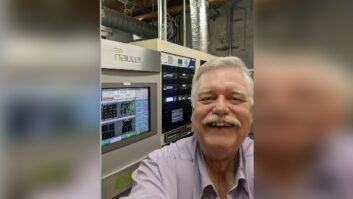COLLEGE STATION, Texas When the owners of Bryan Broadcasting approached me about upgrading KNDE(FM) to include HD Radio, the thought was exciting and scary.
Bryan Broadcasting owns five radio stations in the Bryan-College Station, Texas market, which includes approximately 48,000 students at Texas A&M University and almost 11,000 more at Blinn College.

KNDE GM Ben Downs and author Chris Dusterhoff We knew we had a population of young people willing to adopt new technology. We also figured that if we offered radio content that was not currently available, this could be a very successful venture for us.
Choosing the programming for the HD channels was a pretty easy decision. The FM runs a CHR format called Candy 95. For the HD2 we chose an active rock format branded “Rock Candy.” Despite being a college town, the market had no such offering. The HD3 is branded as “Play by Replay.” It has live and rebroadcast sporting events from four area high schools, as well as some Texas A&M sports such as volleyball, soccer and softball, that previously had little or no radio coverage.
Considerations
The programming was the exciting part. The scary part was I needed to find the equipment to meet our needs.
We had to consider the initial cost of the equipment, the ongoing cost of running and cooling the transmitter and available and knowledgeable customer service. We also needed to make sure we were prepared in the event the FCC approved increased power levels for the HD sidebands.
Our analog TPO was 15.6 kW and we wanted a transmitter that could handle common amplification of not only the –20 dB, which was allowed at the time, but also the –10 dB level that was being proposed to the FCC.
After evaluating our options, we decided on the HPX40 transmitter from Harris. The transmitter was purchased along with the complete Harris FlexStar multicasting system, including the HDI-100 importer, HDE-200 embedded exporter and the HDx exciter.
We also decided to keep our current Harris HT20 transmitter as a full-power analog backup transmitter. After adding a dummy load and RF switch to the transmitter facility, we were ready to install the new transmitter with minimal down time.
The design of the HPX40 made the installation simple. The layout of cabinets helped with that. The external connections to the transmitter, including the three-phase wiring and remote control, were easily accessible and well labeled. The WAGO connectors used for the remote control and monitoring allowed me complete the installation wiring in half a day. The remote connections required no soldering in tight spots and were located to minimize the need to route wires through the cabinet.
Harris shipped the FlexStar importer and exporter in advance of the transmitter. These are located at the studio with all the processing. That configuration made for easy connection of the audio and data for all three signals. It also allows the engineering staff to keep an eye on them. We had the opportunity to have those configured and connected to our Moseley Starlink STL prior to the transmitter install.
Harris assisted in the installation, sending field service engineer Walter Freeman and product manager Terry Cockerill to the site to prepare for the launch. With the connections made, we turned on the transmitter into the dummy load. This was my first experience watching the real-time adaptive correction work. With a little tuning, I watched on the built-in spectrum analyzer in the exciter as the RTAC brought the signal under the NRSC-5B RF emission mask.
KNDE has since received special temporary authorization to operate at –14 dB and plans to move to –10 dB as soon as is allowed by the FCC. Increasing the sideband level was as easy as changing one setting through the front panel of the exciter. The HPX and FlexStar system has worked well at –14 dB, and we look forward to the opportunity to run it at the full –10 dB soon.
Chris Dusterhoff is chief engineer with KNDE(FM), Bryan Broadcasting.
For information, contact Harris Broadcast in Ohio at (503) 459-3400 or visitwww.harris.com.











